Part 2:Project Covid-19 Report

Welcome back, readers! This is the second part of our report.
Spain 
On 30th January 2020, the Director-General of the World Health Organization declared the outbreak of COVID-19 to be a Public Health Emergency of International Concern.
How did the pandemic start to spread?
The first confirmed case of COVID-19 in Spain was reported on 31st January 2020, when a German tourist tested positive in the Spanish Canary Island. However, this was an isolated imported case. Spain and Italy were, at that time, the epicentres of the COVID-19 pandemic in Europe. Spain experienced the highest number of cases, while Italy observed the highest number of deaths.
The first wave of COVID-19
The first wave of the coronavirus disease (COVID-19) pandemic spread rapidly in Spain, one of Europe’s most affected countries. A national lockdown was implemented on 15th March 2020. COVID-19 case numbers began declining 6 days after the national lockdown. The first wave of coronavirus in Spain had a severe impact on the elderly.
The second wave of COVID-19
The first case of the new strain was detected in northern Spain in June 2020, just one day before the country reopened its borders to EU tourists.
Getting an idea using metrics
Finding positive rate,
Total number of PCR tests: 15,502,165
Total number of confirmed cases: 2,111,782
Positive rate=  = 13.6%
= 13.6%
*According to criteria published by WHO in May, a positive rate of less than 5% is one indicator that the epidemic is under control in a country.
Tests per confirmed case= =7(nearest integer)
=7(nearest integer)
WHO has suggested around 10 – 30 tests per confirmed case as a general benchmark of adequate testing.
Finding the daily tests per thousand people,
Population of Spain: 46,754,778
No. of tests (from 9 Oct to 15 Oct)=71,106
Average number=  = 10,158
= 10,158
Daily tests per thousand people= =21.7%
=21.7%
Spain is the 8th country with the highest number of coronavirus patients. From what the above calculations show, Spain does not have the general benchmark of adequate testing which was suggested by the WHO.
Given below is the number of coronavirus cases as of 25th November 2020

This is the number of coronavirus deaths that occurred as of November 25th 2020.
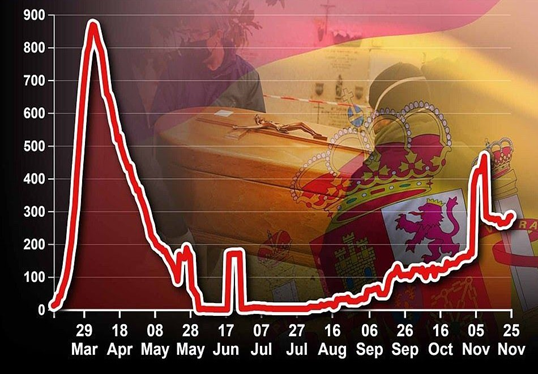
Vaccinations
The COVID-19 vaccination in Spain is the national vaccination strategy started on 27th December 2020, to vaccinate the country’s population against COVID-19 within the international effort to fight the COVID-19 pandemic. As of October 12th 2021, the following doses had been received: 58,123,059 Pfizer–BioNTech COVID-19 vaccine doses, 10,801,000 Moderna vaccine doses, 14,811,980 Oxford–AstraZeneca vaccine doses and 2,659,000 Janssen vaccine doses, totaling to 87,395,039 doses. Out of these doses, 70,822,813 had been administered.
References
https://en.wikipedia.org/wiki/COVID-19_vaccination_in_Spain
Iceland 
On 30th January 2020, the Director-General of the World Health Organization (WHO) declared the outbreak of COVID-19 to be a Public Health Emergency of International Concern. Iceland’s first COVID-19 case was reported on February 28th.
After successfully containing the first local wave of COVID-19 infections last spring, Iceland reported a low number of cases throughout the summer. Another larger wave occurred in the fall and Iceland is currently reporting several new cases daily. The first doses of the COVID-19 vaccine arrived in Iceland on December 28th and vaccination began on December 29th.
How did the pandemic start to spread in Iceland?
The Department of Civil Protection declared an uncertainty phase on 27th January in response to the unfolding outbreak of COVID-19 in China. Targeted Testing for COVID-19 started on January 31st 2020, in Iceland for persons who were at high risk of infection. On 28th February 2020, Iceland confirmed the first case of COVID-19, an Icelandic male in his mid-forties who had been on to Andalo in Northern Italy and returned to Iceland on 22nd February.
By March 2nd, the total cases reported had risen to a total of nine; all of which were reported only in the Reykjavík area. Five of these cases were traced to Italy. In response, the Directorate of Health defined Italy as a risk area for the disease and everyone arriving in Iceland from Italy were asked to go into a 14 day home quarantine.
On March 3rd, in an official press report, sanctions were announced for those who would break the quarantine, which includes up to three months in prison, as it is considered an intentional contagion of the virus.
On March 17th, the first person infected with coronavirus was confirmed dead; a 36-year-old. It was an Australian citizen suffering from a serious illness who died shortly after hospitalization. Dr Brynjólfur Þór Guðmundsson stated that COVID-19 was the probable cause of the death, however, this statement was later challenged by Dr Þórólfur Guðnason, the chief of the health Directorate’s nation vaccination program, stating that though the deceased was infected with the virus, it is unlikely for it to be the cause for the death because his symptoms came up quickly and were not those usually associated with COVID-19 deaths.
How has it varied over time?
On April 5th, Iceland reported the highest number of active COVID-19 cases during the outbreak, at 1,096; since then, recoveries per day have outnumbered new cases. Six months after the first patient was found, the second wave of COVID-19 broke out in mid to late September, in a cluster found in two restaurants; The Irishman and Brewdog were ultimately traced to two French tourists who were tested positive mid-August but did not follow all rules of quarantine. Since 27th November, no new cases have been reported outside of quarantine. By December 28th, the 29th death was reported in Iceland with a total of 5,736 reported cases.
The charts show the spread and impact of COVID-19


Getting an idea using metrics
Finding positive rate;
Total number of PCR tests: 329,598
Total number of confirmed cases: 5,867
Positive rate= ![]() × 100% = 0.0178% (3 s.f.)
× 100% = 0.0178% (3 s.f.)
*According to criteria published by WHO in May, a positive rate of less than 5% is one indicator that the epidemic is under control in a country.
Tests per confirmed case = ![]() = 56 (nearest integer)
= 56 (nearest integer)
*WHO has suggested around 10 – 30 tests per confirmed case as a general benchmark of adequate testing.
Finding the average number of tests done per day.
Number of tests done in 14 days = 34,353
Average number of tests done in 1 day =![]() =2,454 (nearest integer)
=2,454 (nearest integer)
From these results, it can be concluded that Iceland is currently doing adequate testing. Because limited testing makes it likely that many cases will be missed, the positive rate can also help our understanding of the spread of the virus. In countries with a high positive rate, the number of confirmed cases is likely to represent only a small fraction of the true number of infections. And where the positive rate is rising in a country, this can suggest the virus is spreading faster than the growth seen in confirmed cases.
Below a (linear and log) graph has been attached to show the variation of a positive rate of Iceland.
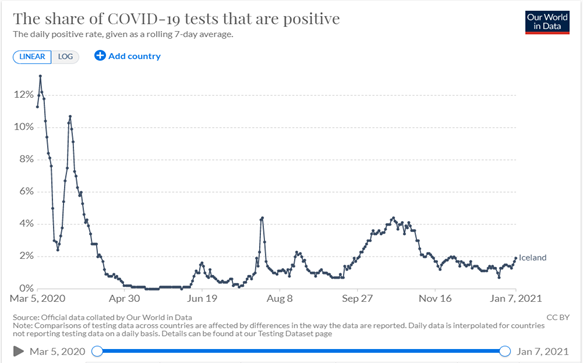

Vaccinations
COVID-19 vaccination in Iceland is an effort to immunize the adult population of Iceland due to the COVID-19 pandemic. As of July 2021, more than 260,000 individuals have received at least one dose of the COVID-19 vaccine, which is over 78% of the country’s population. The vaccines approved for use in Iceland are:
- BioNTech, Pfizer vaccine
- Johnson & Johnson vaccine
- Moderna vaccine
- Oxford, AstraZeneca vaccine
Resources
https://en.wikipedia.org/wiki/COVID-19_pandemic_in_Iceland
Germany 
On 31st December 2019, the World Health Organization’s (WHO’s) country office in China detected a series of cases of “viral pneumonia” in Wuhan prompting the world to be on high alert. This study plans to show an overview of the significant challenges Germany faces through community transmission, in which the nation tries to maintain international, healthy and socio-economic safety guidelines.
How did the pandemic start to spread?
On the 20th of December, a woman on arrival at Germany’s Frankfurt airport from London Heathrow was tested positive for COVID-19 after developing minor symptoms. She had been made isolated at her family’s residence in Baden Wuerttemberg and shortly afterwards, 3 individuals within her exposure were also quarantined. This presence brought the state’s Southwestern Health Minister to release a statement quoting, “this is the first known case in Germany”. Subsequently, on 27th January, it was inevitable that Germany produced and reported its first-ever confirmed case in Bavaria. The patient was isolated in a hospital and later was stated to be in good condition.
In addition, on 1st February, it was instructed that local public authorities had to be given a 24-hour report by every state health provider on all potential cases. On February 27th, Germany endured a gradual increase of confirmed cases bringing the total up to 26 cases within the country. This led up to the government establishing an inter-ministerial national crisis in response to the uprising.
The next day, approximately 1000 people were quarantined within the district of Heinsberg in North Rhine-Westphalia after the number of confirmed cases increased to over 50. The government, being on high alert, closed down schools and day-care centres in the region as well as had travellers from selected countries provide contact information as a precaution to tracing their movements.
On 19th March, Germany imposed their first-ever nationwide restriction to counter-balance the community transmission into various other German states that had also acquired the virus. Being a federal nation, power is diversified into 16 German states who agreed on temporarily banning religious services, banks, supermarkets and closing non-essential shops. On the contrary, given that each state has a local governor, there are differences between the way each region worked on containing the virus. On 12th May, a slaughterhouse in North Rhine-Westphalia had been identified with 260 workers infected. Furthermore, the overall deaths in Germany increased up to 7533 with a daily average of deaths between 100 – 200.
How has it varied over time?
The nation of Germany was highly commended by the international community for its effective handling of the first wave. However, despite such efforts, the country underwent a second wave.
On 27th October, Germany’s 16 state leaders held a meeting on containing the spread of the virus. On November 2nd, all 16 states came to the decision of implementing a partial lockdown, allowing the 16 state governors to impose and lift restrictions but essentially is a plan on closing all public forms of entertainment while leaving schools and nurseries open.
Later that month, it was reported that the country suffered from additional confirmed cases of 14,964 and 27 deaths. A strict nationwide lockdown was imposed by the government on December 16th instructing restaurants, theatres, gyms as well as other non-essential firms and industries to temporarily close down until restrictions are to be lifted on January 10th 2021. The five-person limit on individuals was eased between 24th to 26th December, indicating that individuals above the age of 14 were able to meet in 4 separate households, not being restricted to 2.
Germany, on 31st December, reported a significant rise in the number of coronavirus related deaths by 964 and infections taking the number of 32,552 making its second-highest daily total of coronavirus cases. On January 5th 2021, the Robert Koch Institute (RKI) (Germany’s public health institute) revealed that more than 1000 COVID-19 based deaths, as well as 21,273 cases, had been recorded in the last 24 hours, prompting the lockdown to be further extended till at least 31st January 2021.
The graphs show the spread and impact of COVID-19;

Getting an idea using metrics
Finding positive rate;
Total number of PCR tests: 35,120,000
The number of confirmed cases: 1,953,426
Positive rate =  × 100%=5.56% (3 s.f.)
× 100%=5.56% (3 s.f.)
Tests per confirmed case = = 18 (nearest integer)
= 18 (nearest integer)

Vaccinations
The COVID-19 vaccination campaign in Germany began on 26th December 2020. As of 19th September 2021, 55,869,314 people have received at least one dose (67.2 % of the total population), while 52,503,166 people have been fully vaccinated (63.1 % of the total population).
- BioNTech, Pfizer vaccine
- Johnson & Johnson vaccine
- Moderna vaccine
- Oxford, AstraZeneca vaccine
Resources
https://www.aa.com.tr/en/europe/germany-records-first-confirmed-case-of-coronavirus/1716065
https://ourworldindata.org/covid-exemplar-germany
https://www.thelocal.de/20200319/how-are-germanys-16-states-dealing-with-coronavirus-pandemic
https://www.bbc.com/news/world-europe-52632369
https://www.nytimes.com/interactive/2020/world/europe/germany-coronavirus-cases.html
https://www.aa.com.tr/en/europe/germany-covid-19-cases-deaths-rise-despite-lockdown/2100208
https://www.worldometers.info/world-population/germany-population/
https://ourworldindata.org/coronavirus-testing
JAPAN 
The COVID-19 pandemic in Japan is part of the worldwide pandemic of coronavirus disease 2019 (COVID-19) caused by severe acute respiratory syndrome coronavirus 2 (SARS-CoV-2).
How did the pandemic start to spread?
The Japanese government confirmed the country’s first case of the disease on 16th January 2020, in a resident of Kanagawa Prefecture who had returned from Wuhan, China. The first known death from COVID-19 was recorded in Japan on 14th February 2020. Both were followed by a second outbreak introduced by travellers and returnees from Europe and the United States between 11th March 2020 and 23rd March 2020. According to the National Institute of Infectious Diseases, the majority of viruses spreading in the country derive from the European type, while those of the Wuhan type began disappearing in March 2020.
On 5th October 2020, the number of confirmed cases in Japan exceeded the number of confirmed cases in China, and at the end of the month, the number of confirmed cases in the country crossed the 100,000-mark. The number of confirmed cases in Japan also crossed the 200,000-mark on 22nd December 2020, the 300,000-mark on 14th January 2021, the 700,000-mark on 21st May 2021 and the 900,000-mark on 30th July 2021.
At the end of 2020, there were about 230,000 COVID-19 cases in the country, nearly 2.7 times the number of COVID-19 cases in China. On 16th January 2021, the first anniversary of the beginning of the pandemic in Japan was commemorated. It was two days after the number of confirmed cases in the country exceeded 300,000. On 27th April 2021, the number of deaths in Japan crossed the 10,000-mark. The number of confirmed cases in the country exceeded the number of confirmed cases in Portugal on 6th August 2021 and crossed the one-million mark the following day.
How has it varied over time?
By the time the Tokyo Olympics ended, there were more than a million cases in Japan. On 25th September 2021, the number of confirmed cases in the country exceeded the number of confirmed cases in Czechia. More than a week later, on 5th October 2021, the first anniversary of the day when the number of confirmed cases in Japan exceeded the number of confirmed cases in China was commemorated.
Japan is one of the most affected countries in the world. Six prefectures in the country, named Tokyo, Osaka, Kanagawa, Saitama, Aichi and Chiba, are more affected than China. Japan is also the most affected country in East Asia. Cases in the country constitute nearly seven-tenths of cases in East Asia. Tokyo is the most affected prefecture in Japan, with nearly 380,000 cases. The country also joined the list of 40 countries with the most COVID-19 cases on 9th January 2021, a few months after becoming the most affected country in East Asia by overtaking China in terms of the number of infections. About seven months later, on 14th August 2021, Japan joined the list of 30 countries with the most COVID-19 cases, a week after the number of confirmed cases in the country exceeded a million. On 15th September 2021, Japan joined the list of 25 countries with the most COVID-19 cases. Five weeks later, on 20th October 2021, the country left the list of 25 countries with the most COVID-19 cases. On a global scale, cases in Japan constitute about 0.7% of global cases.
The Japanese government adopted various measures to limit or prevent the outbreak. On 30th January 2020, former prime minister, Shinzo Abe, established the Japan Anti-Coronavirus National Task Force to oversee the government’s response to the pandemic. On 27th February 2020, he requested the temporary closure of all Japanese elementary, junior high, and high schools until early April 2020. On 7th April 2020, Abe proclaimed a one-month state of emergency for Tokyo and the prefectures of Kanagawa, Saitama, Chiba, Osaka, Hyogo, and Fukuoka on 16th April 2021.
Getting an idea using metrics
Finding positive rate,
Total number of PCR tests: 26,863,887
Total number of confirmed cases: 1,724,319
Positive rate= (1,724,319/26,863,887) /100% = 6,42%
*According to criteria published by WHO in May, a positive rate of less than 5% is one indicator that the epidemic is under control in a country.
Tests per confirmed case= 26,863,887/1,724,319 =15 (nearest integer)
WHO has suggested around 10 – 30 tests per confirmed case as a general benchmark of adequate testing.

Vaccination
The COVID-19 vaccination in Japan began on 17th February 2021, more than a month after the first anniversary of the beginning of the pandemic in the country was commemorated. As of 22nd October 2021, about 96.4 million people in Japan received at least one dose of the COVID-19 vaccine while about 86.9 million were fully vaccinated.
On 14th February 2021, Pfizer was approved by the government of Japan and was deployed on 17th February 2021. On 28th May 2021, Pfizer was approved by the Japanese health ministry panel for adolescents aged between 12 and 15 years.
On 21st May 2021, Moderna and AstraZeneca were approved by the government of Japan.


Resources
https://en.wikipedia.org/wiki/COVID-19_pandemic_in_Japan
https://ourworldindata.org/coronavirus/country/japan
https://www.mhlw.go.jp/stf/covid-19/kokunainohasseijoukyou_00006.html
Sri Lanka 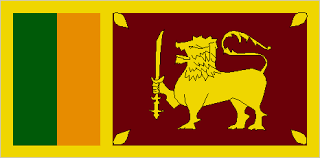
The World Health Organization declared COVID-19 as a pandemic on 11th March. Sri Lanka is currently experiencing a cluster epidemic with a specific group of overseas returnees and their contacts. The objective of this study was to develop a mathematical model to predict the epidemic in Sri Lanka incorporating measures taken for social distancing and prevention of social gatherings.
How did the pandemic start to spread?
On 27th January, the first confirmed case of the virus was reported in Sri Lanka, a 44-year-old Chinese woman from Hubei Province in China. She fully recovered and was released from the hospital on 19th February. 33 Sri Lankan students and families were evacuated from Wuhan on 1st February and were kept under quarantine at a Military facility in Diyatalawa. They were released after a two week quarantine period.
Since the first week of March, passengers coming from Italy, Iran, or South Korea were required to be quarantined for two weeks at one of two facilities. On 10th March, 186 people (164 Sri Lankan nationals, 20 Italian nationals, and 2 South Korean nationals) were placed under quarantine in Batticaloa. On 10th March 2020, 2 Sri Lankan origins living in the United Arab Emirates reported with coronavirus cases were identified. On 10th March, the first Sri Lankan tested positive for COVID-19; a 52-year-old tour guide working with a group of Italians had tested positive.
He was treated in Infectious Disease Hospital (IDH), Angoda. Twenty-nine patients were under observation in government hospitals, including eight foreigners. On 12th March, a 44 year old person, who had reportedly stayed with the first Sri Lankan patient diagnosed with the virus and admitted at Infectious Disease Hospital, Angoda, had also tested positive for coronavirus. On 15th March, 7 more new confirmed cases were reported taking the overall tally to 18 and the surge of new cases cautioned the government to declare 16th March a public holiday but later extended the holiday until Thursday, 19th March. On 16th March, 10 more cases were reported, taking the tally to 28. On 17th March, another 15 more cases were reported taking the tally to 43. On 17th March, the Secretary to the Ministry of Defence, Kamal Gunaratne, revealed that around 170 passengers who returned from Italy and South Korea had neglected the quarantine procedure.
How has it varied over time?
By the end of September, the first wave ended with a total number of cases of 3374; 13 dead, 3230 recovered and others still hospitalized. The second wave began on 4th October, five months after the first patient was discovered in the community, while the Minuwangoda and Divulapitiya cluster began on 23rd September. On 12th October, a total of 90 new COVID-19 cases were reported as of 7:00 pm, which brought the total cases in the Minuwangoda cluster to 1397.
The government was reluctant to enforce another lockdown as they feared that this would drive businesses out of business and their employees out of a livelihood. On 13th October, total cases in the Minuwangoda cluster rose to 1446. Sri Lanka Bureau of Foreign Employment announced that from 8th October onwards, 67 Sri Lankan migrant workers had died from COVID-19. The deaths were reported from mostly Middle East countries. More than 2600 Middle East workers have tested positive for the COVID-19 virus. COVID-19 patients were found in the Brandix Minuwangoda textile factory.
Patients’ families were sent to the IDH hospital. Later on, three major institutes were closed. The University Grants Commission announced Kelaniya University, Gampaha Wickramarachchi Ayurveda Institute and Naiwala Advanced Technological Institute were being closed for one week. Police curfew has been imposed in Divulapitiya and Minuwangoda until further notice, Sri Lanka police said. On 12th October, Hela Clothing group said an employee had tested positive at its Thihariya plant. The plant was closed. 12 Lanka Electricity Company employees were infected with SARS-CoV-2. They worked at the Kandana branch. 120 people were arrested for curfew violations in lockdown areas.
From 2020 onwards
The charts show the spread and impact of COVID-19;



The below charts show the impact of the virus in 2021.


Getting an idea using metrics
The graph attached below shows the variation of positive rate for Sri Lanka:

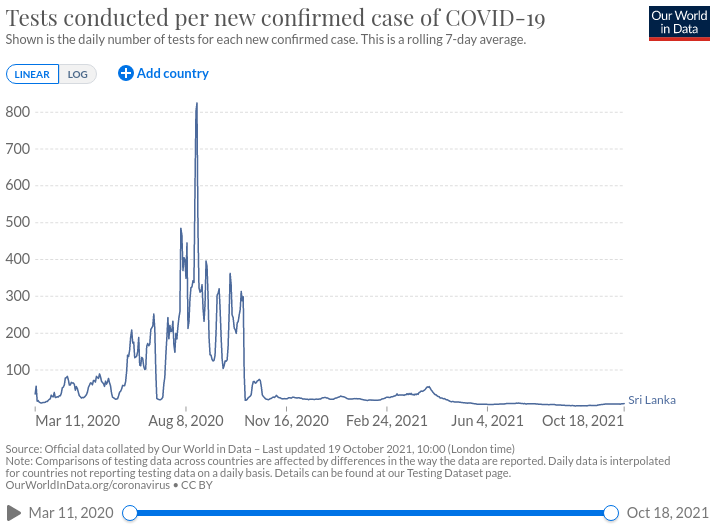
The following graph gives an idea of the variation of the number of testing done in Sri Lanka.

Finding the daily tests per thousand people (As an average for the period 21st September to 20th October).
Population of Sri Lanka: 21,530,791 (20th October)
No. of PCR tests: 210298
No. of Rapid antigen tests:102641
Total tests = 210298+102641=312939
Average number of tests per day =  = 10431.3
= 10431.3
Daily tests per thousand people =  = 0.48(2 s.f.)
= 0.48(2 s.f.)
From these results, it can be concluded that Sri Lanka is not currently doing adequate testing. Because limited testing makes it likely that many cases will be missed, the positive rate can also help our understanding of the spread of the virus. Sri Lanka has a high positive rate (more than 5%). So the number of confirmed cases is likely to represent only a fraction of the correct number of infections. The positive rate was generally rising until around 18th October. This can suggest the virus is spreading faster than the growth seen in confirmed cases. However, as the positive rate has started to decline, the spread of the virus has started to reduce.
Vaccination
Sri Lanka started vaccination in late January 2021.
The vaccines currently approved for use in Sri Lanka are:
- Moderna: mRNA-1273
- Pfizer/BioNTech: BNT162b2
- Gamaleya: Sputnik V
- Oxford/AstraZeneca:AZD1222
Serum Institute of India: Covishield (Oxford/AstraZeneca formulation)
Sinopharm (Beijing): BBIBP-CorV (Vero Cells)

During last week’s report, Sri Lanka averaged about 59,476 doses administered each day. At that rate, it will take approximately further 70 days to administer enough doses for another 10% of the population assuming each person will be administered with two doses.
The following chart shows the immunization progress as of October 24th.
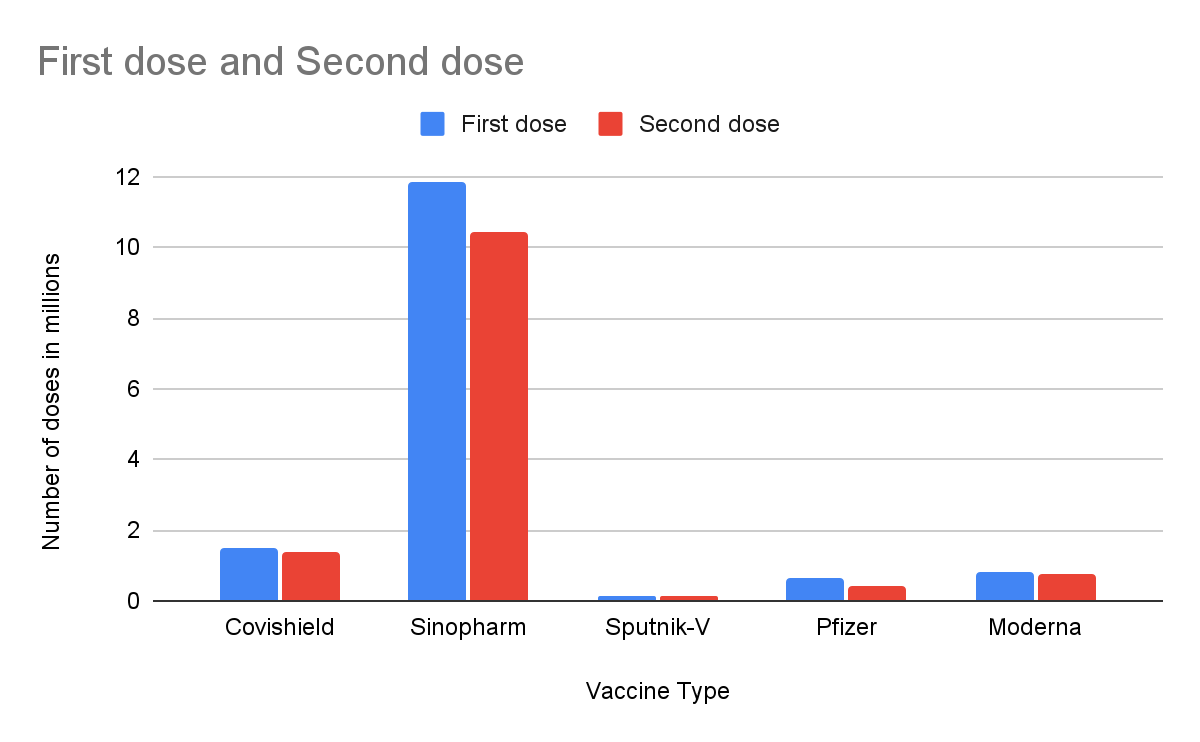
Total second doses given=1387229+10410309+155654+432125+771257=13156574
Percentage of the population=
Generally, each person needs to be administered two doses for optimum immunization, though some recommend giving a third dose. According to the data, we can conclude that Sri Lanka has made good progress in immunization.
Resources
https://hpb.health.gov.lk/covid19-dashboard/
https://www.epid.gov.lk/web/index.php?option=com_content&view=article&id=225&lang=en
https://ourworldindata.org/coronavirus-testing
https://disease.lk/covid-sl-timeline/
https://www.worldometers.info/world-population/sri-lanka-population/
https://covid19.trackvaccines.org/country/sri-lanka/
http://www.epid.gov.lk/web/index.php?option=com_content&view=article&id=231&Itemid=487&lang=en
https://graphics.reuters.com/world-coronavirus-tracker-and-maps/countries-and-territories/sri-lanka/
We have published the last part of the report!



